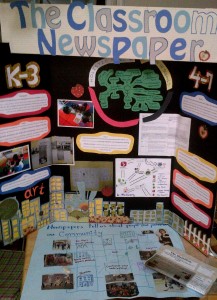After four hours of a terribly stressful dream about losing my cool as a classroom teacher, I woke up to three alarms that S and I had set the previous night. We caught the 6a.m. bus that took us to the ferry terminal, and arrived in Gibsons, B.C. for our morning presentation at Cedar Grove Elementary School.
When we were in Uganda planning the kindergarten project, we had no resources to jump- start the vision. Our community in Busolwe wanted to establish a school that was attached to the library, and our role in the project was to design a guiding curriculum and present a budget to the Board of Directors of the library association so that they would endorse the plan. S. Sammartino contacted her mother who is a kindergarten teacher on the sunshine coast, and students raised enough money to purchase wood and hire a local carpenter who made the desks and chairs. After our departure, the Busolwe library community interviewed and hired teachers from the capital city, and with a surge in enrolment the school population was close to 200 students in its first year!
Our first fundraiser presentation last year raised over $500 Cdn and that went towards supplying and creating 5 additional classroom spaces for students in K-7. Today’s presentation was a virtual tour through our classroom, and the students were amazed by the great impact that their small coin contributions had made.
Following our presentation, teachers had booked us to come into their classrooms to debrief with the students. Last year we had spoken to all the intermediate students, so this year we visited all the primary classrooms. Students asked us what kind of food we ate, what languages are spoken in Uganda, how far the community was, and why did we name it Mango Grove school. It was amazing to share with the students their wonders and personal connections to this community of students halfway across the world.
It was extremely touching to speak to teachers and other workers in the school about why we still do this on the side of our busy lives. On our ferry ride home, I remarked that it felt like we were leading two lives. For me, this was one busy student teacher life; for Stephanie one busy counselor life; for Hannali one busy life of an aspiring diplomat. It was powerful to watch the video of our simple presentation. Although Busolwe still has many areas in which they are developing, the students who now attend Busolwe Mango Grove have become part of our lives. In a way, we have become international development workers without having anticipated so. Though we have our individual aspirations driven by our passions for education/counseling/international relations, our paths are woven together in this particular segment of our lives.
I am so blessed to have such loving, caring, big- hearted friends who believe in the potential impact of small actions in kindness and hope. At the end of extremely stressful or discouraging days, I remind myself that as long as my actions are grounded in purpose and meaning, any bad day will pass. On the whole, I have made a difference, however small.
“To the world, you may only be one person; but to one person, you could mean the world.”
